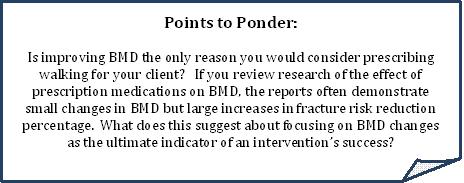Research Summary: Hip Fractures & Exercise
3.3.1 Post Hip Fracture Exercise
A recent Cochrane review21 of mobilization strategies post osteoporotic hip-fracture suggested:
- There is insufficient evidence overall to establish the effectiveness of the reviewed mobilization strategies used in rehabilitation after hip fracture surgery (including physiotherapy, treadmill, resistance training & electrical stimulation)
- Limited number of trials, limited power
- Little information about persistence
Two positive RCT studies (Binder 3, Hauer 22):
Concluded that improved mobility occurred with intensive, supervised ongoing exercise/therapy, specifically with significant differences between the exercise and control groups in the following measurements:
- Improved walking velocity
- Less need of walking aid
- Improved measures on the Physical Performance Test
- Improved Stair climbing
- Increased leg extensor strength, decreased fear of falling, improved balance
Interestingly, no change in BMD was found2
What were the characteristics of these two positive trials?
- Exercise was prescribed for 3x/wk for 3 months or 6 months
- Patients were supervised in an outpatient centre, using machines
- Progressive resistive training at 70-90% or 65% max
- Included functional training – walking, stepping, balance activities
More recent work has revealed:
- Higher intensity, weight-bearing exercise are not better than lower intensity seated or lying exercises for mobility and balance 40
- Increased muscle strength and power with 2x/wk supervised resistance training for 12 wks 43
- Arm ergometry + inpatient rehabilitation improved aerobic fitness, mobility and balance 38
3.3.2. Conflicting Reviews on Walking Benefits
Cochrane Review: Exercise for preventing and treating osteoporosis in postmenopausal women4,5
- 3 studies utilizing walking programs
- comparison to control groups
- walking program: high intensity, 3x/wk, 30-45 minutes
- analyzed results showed walking to have a positive effect on the BMD of spine 1.31[95%CI (-0.03 to 2.65)] and the hip 0.92 [95%CI(0.21 to1.64)]
Author’s conclusion: Walking resulted in statistically significant improvements of BMD in lumbar spine and hip. The authors suggest that this program may be easiest, simplest and best program for implementation long-term.
Meta-analysis of walking for preservation of bone mineral density in postmenopausal women34
- Meta-analysis carried out in line with Cochrane Collaboration guidelines
- 8 walking studies reviewed – 5 RCT studies and 3 non-randomized trials
- All utilized control groups
- Walking program amongst 8 studies varied (self-paced, brisk pace, pace based on heart rate, treadmill walking & outdoor walking)
- 8 showed relative change in lumbar spine BMD of 0.39%
- 5 studies examined femoral neck BMD – a relative change of 0.35%
Author’s conclusions: walking as a singular exercise intervention is not sufficient to preserve BMD at the spine or hip in post-menopausal women. The effects on BMD may be clinically too small to impact reduction of fractures.
